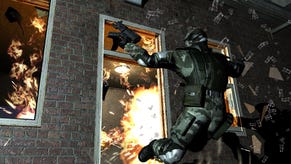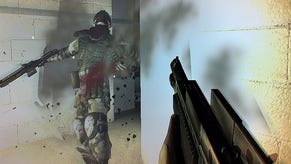F.E.A.R
We go hands-on with the single-player portion of Monolith's John Woo-inspired action FPS.
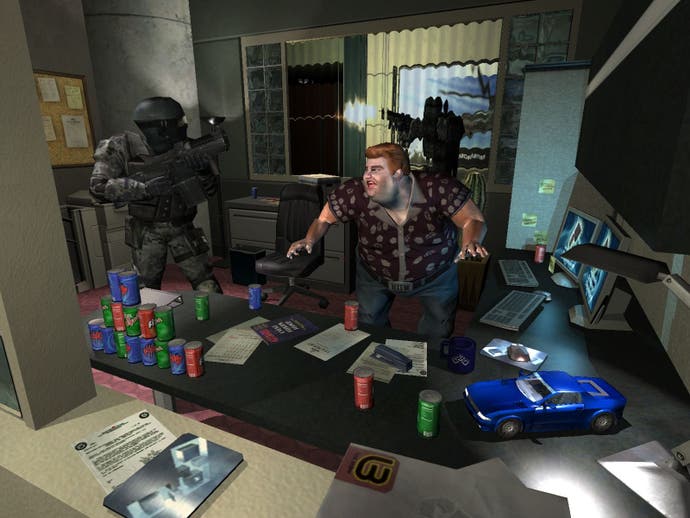
One of the biggest frustrations about being a gamer is the weight of expectation that inevitably gets heaped onto promising sounding games. After Tom's almost hysterical loving praise upon being greeted with F.E.A.R for the first time a couple of months back it was hard to approach the game with the same sense of unburdened awe. If someone as openly bored of First-Person Shooters as he is could spend several thousand words attempting to invent new superlatives and end up calling it this year's Half-Life 2 you end up approaching it already expecting to have your nose bloodied at fifty paces. I brought my hanky to cover both bases.
After sitting through an undeniably impressive 15-minute run-through of the game's second level I was finally let loose. With little-to-nothing known about the precise nature of your mission or why you're even creeping around these docks in the first place much of what was seen or played has limited context. Suffice to say you're part of a Delta Force squad assigned to investigate strange goings-on.
Arriving at a locked iron gate you're tasked with trying to find a way in, and sure enough once you weave your way through a section of stacked boxes, a staircase on the side of a storehouse leads to a lever and it's game on. Even at this point it's clear Monolith has built a robust engine capable of rendering scenes of fine detail, delivering one of the dirtiest looks to a game ever. It's a grimy, oppressive environment. Paint flakes off the wall, the sense of foreboding from the unwelcoming gloom steeps every prowling step in tensions.
"Oi, don't you dare rush it - I spent two weeks on that desk!"

It's a game where even the most arbitrary location is packed with attention to detail that has the watching Monolith rep ruing "Man, you see people rushing through locations that took us weeks to build!" As if to make him feel better, I creep around, taking my time, shooting the lights and watching the lampshade jerk violently and swing to and fro, casting beautiful real-time shadows across the room. When it looks this good, you don't mind being a bit of a graphic whoring geek for a few minutes. Even the smashing of glass seems more visceral. F.E.A.R feels very much at home with the words 'visceral' and 'intensity' attached to it.
Finally moving through the open gate to catch up with our long departed squaddies the first hint of the horrors to come appears and disintegrates into an inky blackness - rather like the terrifying creatures that stalk Yorda in ICO. Moving through various dimly lit interiors you face well-marshaled enemies, but they're no match for a shotgun at close range. Or a nail gun for that matter. Nailing these dark clad enemies to a wall is almost worth the price of entry alone. Doing it in slow motion is a sight to behold; just a micro moment in your own action movie.
Hitting CTRL kicks off the much-celebrated John Woo slo-mo mode, and hitting it again returns to normal. As a system it is, of course, pretty much identical to the Max Payne school of game design whereby careful use of it gives you a massive advantage in combat situations - especially when trying to dispatch an enemy packed room efficiently. But, well, it's in first-person now.
Maximum Pain
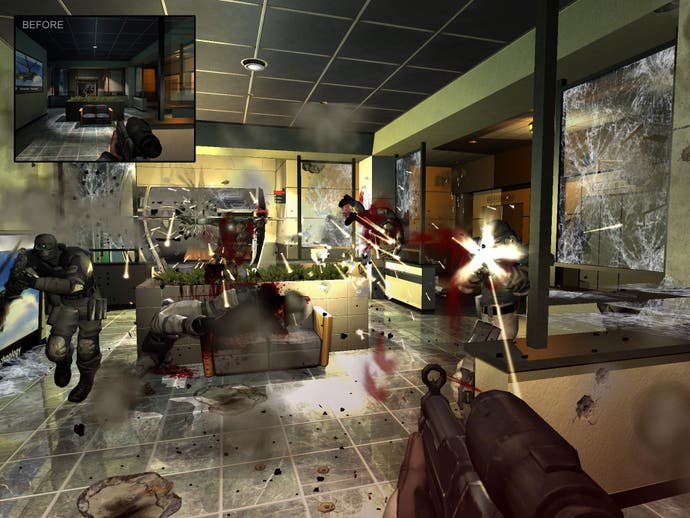
As per usual, shooting more enemies tops it back up and a full bar's worth of bullet time lasts probably no more than about 15 seconds of actual time. It could be less, it could be more; unsurprisingly, this time meddling mechanic messes up your real-life perception of time every bit as much as it's doing in the game. Facing a posse of onrushing enemies it soon becomes one of the game's mainstays as you soak up every last spark, bullet trace and special effect and eke out every last drop before going back to 'normal'.
Much like the famous lobby scene in The Matrix, the devil is in the slo-mo detail, with Monolith going all out to make the game look as cool as possible when you're in this mode. It's just as heart-stopping as we expected, although at this stage you're only exposed to a fairly basic type of grunt soldier threat, with none of the 'surprise' elements exposed to us as yet.
What is certain is the level of malevolence that stalks every room. Freshly killed victims litter the floor, with crimson trails smeared on white tiled floors leading to their unfortunate remains.
Boxing clever
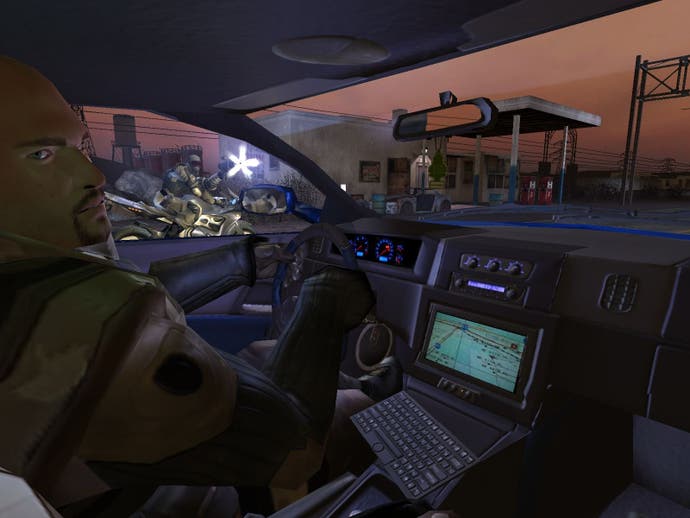
A basic box-moving jump puzzle later, you're once again running the gauntlet and facing off against an aggressive and psychotic enemy intent on your doom. Having been nailed several times in a row in a particularly intense duck and dive session between piled up boxes outside it emerges that the difficulty's been set to 'hard'. No wonder.
It's not a game you can exactly wade into, though, and while there are standard +50 health packs dotted around, you have to choose yourself when to activate them. Simultaneously helpful and tricky, you at least have the ability to restore your health at the point of death right in the thick of a battle with a quick tap of the Z button. Although patently unrealistic it does add a different dynamic to the usual 'run off and get health' approach that's been used pretty much everywhere else.
Another feature worth a mention is the melee combat, with moves like the Slide Kick adding an extra string to your bow when you get the opportunity. One such opportunity presented itself perfectly - albeit in a slightly scripted manner whereby an enemy creeps away from you inside a warehouse, giving you the perfect opportunity to whack them with a melee move before they've even noticed you're there - removing the headache of alerting all the other AI in the area to your presence.
Tom and Jerry
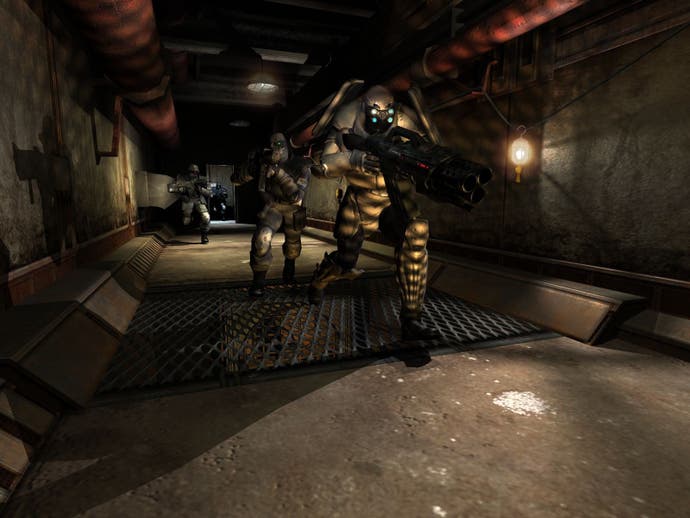
The other alternative to downing enemies is to, d'oh, shoot them, of course, but it might not be the cleverest thing in the world to do under the circumstances as doing so results in everyone in the area making it their business to hunt you down. On this score it's great to see a game where the enemies make it their business to really ask questions of the player, and you'll spend an age sometimes just leaning out from behind boxes and playing little cat and mouse games with them. These are no idle sentry idiots that go back to sleep after 10 seconds. If you make yourself known by being too loud you've got to be very vigilant to their attacks, and it'll be interesting to see how the game plays out later on once Monolith really turns up the heat.
At this stage it's admittedly still far too early to tell quite how F.E.A.R will pan out over the course of its 15-20 hour lifespan. Much of its appeal and many of the surprises that await are being kept well and truly under wraps. But even the most jaded FPS player has to admit this is one to definitely keep a close eye on as we progress through 2005. That hanky might just come in handy after all.
For more on F.E.A.R, read last week's interview, and Tom's take on the game's opening and multiplayer element.


